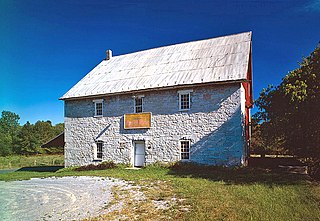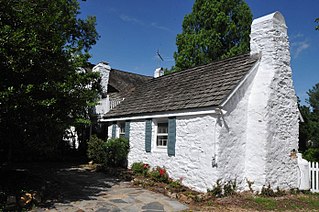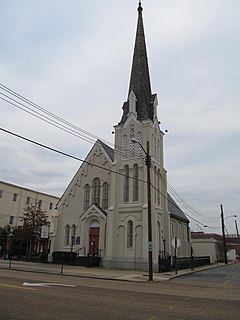
The Bunker Hill Historic District is the center of the town of Bunker Hill, West Virginia. Today located on the road called US 11, the town was developed along the Martinsburg, West Virginia - Winchester, Virginia road. Bunker Hill served southern Berkeley County with three stores, six mills, and five churches. It was also home to a significant African-American population.

Gerrardstown Historic District is a national historic district located at Gerrardstown, Berkeley County, West Virginia. It encompasses 92 contributing buildings, 4 contributing sites, and 2 contributing structures. Notable commercial buildings include the Gerrardstown Corner Store, Wiest Antiques Store, Richard McCormick Store, Charles Crim Store, and David S. Griffith General Store. Most houses are 2 1/2 stories and are representative of a number of popular architectural styles including Queen Anne, Federal, and Greek Revival. Religious properties include the Presbyterian Church (1893) and Cemetery and Southern Methodist Episcopal Church (1883). Also included is the Lutheran Cemetery with burials dating to 1818. Located within the district is the separately listed Hays-Gerrard House.

Sutton Downtown Historic District is a national historic district located at Sutton, Braxton County, West Virginia. It encompasses 85 contributing buildings and two contributing structures covering eleven square blocks. The district includes the commercial, ecclesiastical, and civic core of the town and surrounding residential area. The district includes a number of buildings representative of popular architectural styles from the late-19th century and early-20th century including Romanesque Revival, Colonial Revival, Gothic Revival, and Greek Revival. Notable buildings include the Braxton County Courthouse (1881-1882) and Jail (1905), Sutton Bank Building (1891), Farmers Bank and Trust (1909), Bank of Sutton, Methodist Episcopal Church, South (1896), Kelly / Fisher House. Elk / Midway Hotel (1894), and Katie B. Frame Residence. The two structures are the Bridge over Old Woman Run (1892) and Bridge over Elk (1930).

West Point Historic District is a national historic district located at West Point, King William County, Virginia. The district encompasses 75 contributing buildings and 1 contributing object in the town of West Point. The district includes residential, commercial, and institutional buildings and is notable for its variety of late-19th- and early-20th-century styles and building types. Notable buildings include the William Mitchell House, Anderson-Mayo House, Ware House, St. John's Episcopal Church (1882), Mt. Nebo Baptist Church (1887), West Point United Methodist Church (1889), O'Connor Hotel and annex, Treat-Medlin House (1898), Gouldman House (1923), First Baptist Church (1926), U.S. Post Office (1931), West Point Town Office Building, Citizens and Exchange Bank (1923), and Beverly Allen School (1930s).

Cameron Downtown Historic District is a national historic district located at Cameron, Marshall County, West Virginia. It encompasses 27 contributing buildings in the commercial core developed after a severe fire in 1895 which destroyed much of the downtown area. They are large 2-4 story brick buildings reflecting the Classical Revival and Colonial Revival styles. Notable buildings include the Masonic Lodge 17, Romine Building/Moose Lodge 758, First Presbyterian Church (1907), First United Methodist Church (1894), Hotel Main, Finlayson's 5 & 10/ Senior Citizens Building, Flatiron Building (1896), First Christian Church of Cameron (1896), and Old B&O Freight Station (1878).

Moundsville Commercial Historic District is a national historic district located at Moundsville, Marshall County, West Virginia. It encompasses 72 contributing buildings in the central business district of Moundsville. They are large 2-4 story brick buildings reflecting the Georgian and Late Victorian styles. Notable buildings include the Marshall House, Roberts House, F.O.E. Building (1940), State Food Store (1939), Simpson United Methodist Church (1907), First Christian Church (1899), St. Francis Xavier Roman Catholic Church (1917), Strand Theater (1920), Marshall County Courthouse (1876), and Post Office and Federal Building (1914). Located within the district is the separately listed Ferrell-Holt House.

North River Mills Historic District is a national historic district located at North River Mills, Hampshire County, West Virginia. The district encompasses 25 contributing buildings and five contributing sites. The district lies along Hiett Run, which empties into the North River, a tributary of the Cacapon River. It has become an industrial ghost town, now visited only by summer residents and tourists. The contributing buildings include the Hiett House with shed and privy; Croston House and barn ; North River Mills Grocery ; Shanholtz House, also known as North River Mills Society for Antiquarian Arts and the Diffusion of Knowledge; North River Mills School ; Miller House and associated outbuildings; United Methodist Church ; Kump House ; and the Moreland House. Contributing sites are the cemetery associated with the Kump House, Miller Mill Site, Shanholtz Mill Site, mill pond, and millrace.

Union Historic District is a national historic district located at Union, Monroe County, West Virginia. The district includes 174 contributing buildings, 2 contributing sites, 7 contributing structures, and 1 contributing object in the Union and surrounding areas. Notable properties include the Monroe County Courthouse, Union High School (1939), Monroe County Confederate Monument (1901), Monroe Department Store (1898), Watchman Office, Union Presbyterian Church (1922), Union United Methodist Church, old Baptist Church, All Saints Episcopal Church, old brick Methodist Church, old Union Academy, Old Temperance Hall, Located in the district are the separately listed Elmwood, Walnut Grove and Brig. Gen. John Echols House.

Pickaway Rural Historic District is a national historic district located at Pickaway, near Union, West Virginia, Monroe County, West Virginia. The district includes 126 contributing buildings, 1 contributing sites, and 7 contributing structures centered on Pickaway and surrounding rural areas. Notable properties in the core include the Reverend John Simpson House (1840), Pickaway School (1890), Trinity Methodist Episcopal South Church (1887), Pickaway Store and Post Office, and frame mill and blacksmith shop. Surrounding farms included in the district are the Gilchrist-Pritt-Perrine farms; Overholt-Gilcrist-Pritt and McClung farms; Beckett, Kilcollin, and Lemon farms; and Siebold and Weikle farms.

Scottsville Historic District is a national historic district located at Scottsville, Albemarle County and Fluvanna County, Virginia. The district encompasses 153 contributing buildings, 1 contributing site, and 4 contributing structures in the town of Scottsville. The district includes commercial, residential, religious, factory and warehouse buildings in a variety of popular architectural styles including Federal, Georgian, Greek Revival, Gothic Revival, Italianate, Queen Anne, Prairie, Colonial Revival, and Craftsman. Notable buildings include Scottsville High School (1920), Riverview (1817), Chester (1847), Belle Haven, Oakwood, Herndon House (1800), The Tavern (mid-1700s), Scottsville Presbyterian Church (1832), Disciples Church (1846), Coleman's Store (1914), and the Fore House (1732). Located in the district and separately listed are Cliffside and Mount Walla.

Marshall Historic District is a national historic district located at Marshall, Fauquier County, Virginia. It encompasses 314 contributing buildings and 3 contributing sites in the rural village of Marshall. The district represents a collection of historic buildings with a wide range of building types and architectural styles that date from the end of the 18th century to the mid-20th century. Notable buildings include the Fauquier Heritage and Preservation Foundation building, hosteller's house for Rector's Ordinary, a store and Confederate post office, the Elgin House, former Marshall Pharmacy, the Foley Building, the Gothic Revival style Trinity Episcopal Church (1849), Salem Baptist Church (1929), Marshall United Methodist Church (1899), and the Marshall Ford Company (1916), reputed to be the oldest building built as a Ford dealership in the United States that is still functioning as such.

Orlean Historic District is a national historic district located at Orlean, Fauquier County, Virginia. It encompasses 51 contributing buildings and 2 contributing sites in the rural village of Orlean. The district includes commercial buildings, churches, a post office, a former school, and multiple residences and their ancillary outbuildings that date from the late 18th century to the mid-20th century. Notable buildings include the Orlean Farm House, Smith-Hinkley House, the Anderson-Rector House and Store, the Greek Revival style Thorpe-Cornwell House, Jeffries Store (1885), Orlean Methodist Church (1881-1883), Providence Baptist Church (1883), and Orlean post office building (1956).

Rectortown Historic District is a national historic district located at Rectortown, Fauquier County, Virginia. It encompasses 76 contributing buildings, 3 contributing sites, and 2 contributing structures in the rural village of Rectortown. The district includes dwellings dating back to the 18th century, churches, a school, an Odd Fellows hall, a post office, multiple commercial buildings, and several cemeteries that illustrate the town's growth and development. Notable buildings include the Maidstone Ordinary, the Rector-Slack Log House, the Ashby House, the Georg Mann House, The Brick Store House, Rector's Warehouse and Station, Denham, Maidstone, Rectortown United Methodist Church (1894), the Jackson-Grant House (1924), Slack's Store (1890), and the Mt. Olive Odd Fellows Lodge (1935).

Town of Halifax Court House Historic District is a national historic district located at Halifax, Halifax County, Virginia. The district includes 172 contributing buildings, 1 contributing site, 13 contributing structures, and 1 contributing object in the Town of Halifax. Resources include government, commercial, residential, religious, educational and industrial buildings that date from the early-19th Century to the mid-20th century. Notable buildings include the Rice House, Edmunds/Lewis Office (1869), People's Bank, Beth Car Baptist Church (1892), Christ Episcopal Church, Saint Luke's Christian Methodist Episcopal Church, Dr. Carter House, County Office Building (1915), Town of Halifax Swimming Pool (1930s), Municipal Building/ Fire Station (1950), Halifax Roller Mills (1915), Halifax Planing Mill, Halifax Department Store (1949), and Randolph Theater. Also located in the district is the separately listed Halifax County Courthouse.

Round Hill Historic District is a national historic district located at Round Hill, Loudoun County, Virginia. It encompasses 204 contributing buildings, 1 contributing site, and 1 contributing structure in the town of Round Hill. It includes a variety of residential, commercial, and institutional buildings, with the majority built between 1880 and 1920. Notable buildings include the Gregg-Parks-Potts House, Guilford Gregg Store, Sagamore Hall, James Copeland House (1886), Hibbs House, African Methodist Church (1892), Mount Zion Baptist Church, Round Hill Baptist Church, Round Hill United Methodist Church, Castle Hall, Ford's Store, Round Hill Grocery, and the former Round Hill Railroad Depot (1902).

Blacksburg Historic District is a national historic district located at Blacksburg, Montgomery County, Virginia. The district encompasses 137 contributing buildings and 2 contributing sites in the central business district and surrounding residential areas of the town of Blacksburg. The district includes commercial, residential, and institutional buildings in a variety of popular architectural styles including Greek Revival, Gothic Revival, and Colonial Revival. Notable buildings include the Johnson House, Blacksburg Presbyterian Church #1 (1847), Smith-Montgomery House, Croy House, Spout Spring House, Deyerle's Store (1875-1877), W. B. Conway Building, Presbyterian manse (1907), Sheriff Camper House, Christ Episcopal Church, African Methodist Episcopal Church of Blacksburg, Blacksburg Presbyterian Church (1904), Blacksburg Methodist Church (1910), St. Mary's Catholic Church, Hunter's Lodge Masonic Building (1928), Martin-Logan Store, Lyric Theater (1922), and Ellett's Drug Store (1900).

Downtown Portsmouth Historic District, also known as the High Street Corridor Historic District, is a national historic district located at Portsmouth, Virginia. It encompasses 229 contributing buildings, 1 contributing site, 4 contributing structures, and 1 contributing object in the central business district of Portsmouth. The district encompasses the original 1752 plan of the Town of Portsmouth and includes portions of expansions of the original boundaries dating to 1763 and 1909. It includes a variety of commercial, government, and institutional buildings, with most dating to the years around the turn of the 20th century. Notable buildings include the Captain Baird House, Vermillion Manor (1840), City Hall Building (1878), former United States Post Office (1907-1908), First Presbyterian Church (1877), First United Methodist Churches (1882), St. James Episcopal Church, Ebenezer Baptist Church, YMCA building, Tidewater Building, Southern Aid Building, Colony Theater, Lyric Theater, Blumberg's Department Store, Mutual Drug Company (1946), the New Kirn Building, and the Professional Building. Separately listed are the Commodore Theatre, Portsmouth Courthouse, Pythian Castle, St. Paul's Catholic Church, and Trinity Episcopal Church

Harrisville Historic District is a national historic district located at Harrisville, Ritchie County, West Virginia. The district encompasses 111 contributing buildings, 1 contributing site, and 15 contributing structures in Harrisville. It includes residential, commercial, and governmental buildings dating from the mid-19th through mid-20th century. They are in variety of popular architectural styles including Gothic Revival, Late Victorian, Colonial Revival, and Tudor Revival. Notable buildings include the Heritage Inn, the Lowther Building, Lowther House (1948), the Trading Post, the Deem Building, the Lawrence Building, railroad passenger depot, St. Luke's United Methodist Church, Harrisville Church of Christ, Stout Hardware, and Berdine's 5&10 Variety Store (1915). Located in the district are the separately listed Ritchie County Courthouse and the Harrisville Grade School.

The Park-to-Park Residential Historic District in Fort Madison, Iowa, United States, was listed on the National Register of Historic Places in 2014. The historic district is located to the north of the Downtown Commercial Historic District, generally between Central Park on the west and Old Settler's Park on the east. Both parks are contributing sites. For the most part the district is made up of single family homes built in the late 19th and early 20th centuries. Some of these homes were built as rental properties, while others became so in later years. The Albright House and the Chief Justice Joseph M. Beck House are contributing properties, and they are also individually listed on the National Register. There are also duplexes and a few small scale apartment buildings in the district.

Upper Main Street Historic District is a nationally recognized historic district located in Dubuque, Iowa, United States. It was listed on the National Register of Historic Places in 2005. At the time of its nomination it consisted of 24 resources, which included 18 contributing buildings, and six non-contributing buildings. In 2011 the boundaries of the district were expanded to include four additional buildings on the west side of the 900 block of Main Street. The district is the northern end of the city's most important commercial street. It is situated on a level terrace above the downtown area, located to the east. The buildings located on the east side of Main Street have exposed foundations along the alley because the grade descends in that direction. For the most part the district is made up of commercial buildings, although there is one house, four rowhouses, and a church. All of the buildings are masonry construction, and they are between one and four stories tall. The bell tower of St. Luke's United Methodist Church (1896) is equivalent to an eight-story building. St. Luke's Church and the Interstate Power Company Building are individually listed on the National Register.























